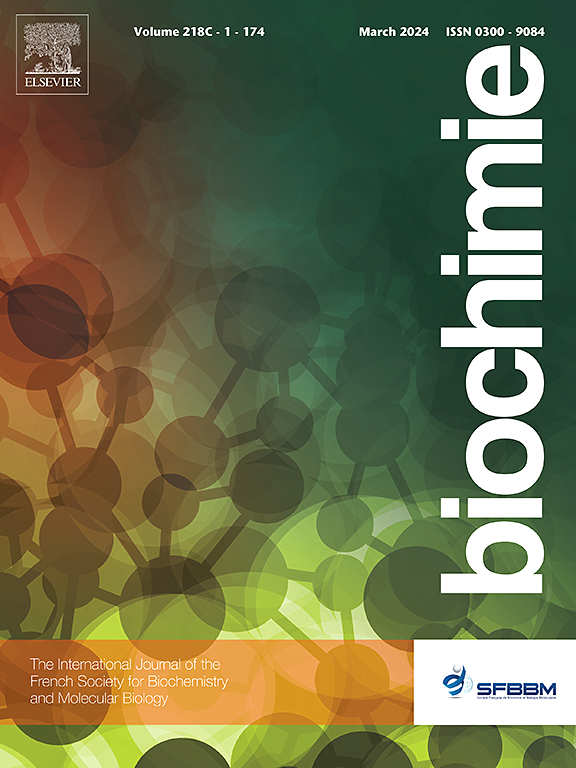Characterization and kinetics of a cathepsin B-inhibiting protein from Musa acuminata Colla peel
IF 3.3
3区 生物学
Q2 BIOCHEMISTRY & MOLECULAR BIOLOGY
引用次数: 0
Abstract
Hyperexpression of cathepsin B caused by an imbalance of endogenous inhibitors is involved in multiple pathologies, hence making it a key therapeutic target. Protease inhibitors are effective biomolecules that regulate protease activities and are considered potential therapeutic agents in various diseases. Plant protease inhibitors have been reported as an effective complementary alternative drug. A proteinaceous cathepsin B inhibitor (CBI-BP) has been isolated from Musa acuminata Colla (banana) peel with a molecular weight of 27.9 kDa on SDS-PAGE. The purity of the CBI-BP was confirmed on the native- PAGE. The isolated CBI-BP showed an IC50 value of 8.14 μg and a Ki value of 10.59 μg (0.19 μM). Cathepsin B inhibition kinetics indicated that CBI-BP follows a mixed-type of cathepsin B inhibition. Its inhibition activity was also confirmed by reverse zymography. The inhibitor was stable from pH 2.6–10.0 with maximum activity at pH 7.2, temperature 25–100 °C and exhibited thermostability for 60 min at 70 °C. MALDI/TOF/MS analysis of CBI-BP showed 40 % similarity to the GH18 domain-containing protein (A0A4S8JRM9) from Musa balbisiana. Although in-silico docking studies showed binding of A0A4S8JRM9 to cathepsin B affects the binding energy of the substrate to cathepsin B but is not reported for any anti-cathepsin B activity. This suggests that isolated CBI-BP might be a novel protein with anti-cathepsin B activity. Thus the isolated CBI-BP may be further explored as possible anti-cathepsin B drug.

阿胶果皮中一种抑制胰蛋白酶 B 的蛋白质的特性和动力学。
内源性抑制剂失衡导致的 cathepsin B 过度表达与多种病症有关,因此成为关键的治疗靶点。蛋白酶抑制剂是调节蛋白酶活性的有效生物分子,被认为是治疗各种疾病的潜在药物。据报道,植物蛋白酶抑制剂是一种有效的补充替代药物。从阿胶(香蕉)果皮中分离出了一种蛋白型酪蛋白酶 B 抑制剂(CBI-BP),SDS-PAGE 分析其分子量为 27.9 kDa。在原生 PAGE 上证实了 CBI-BP 的纯度。分离出的 CBI-BP 的 IC50 值为 8.14 μg,Ki 值为 10.59 μg(0.19 μM)。cathepsin B 抑制动力学表明,CBI-BP 对 cathepsin B 的抑制作用属于混合型。其抑制活性也得到了反向酶谱的证实。该抑制剂在 pH 值为 2.6 - 10.0 的范围内都很稳定,在 pH 值为 7.2、温度为 25 - 100°C 时活性最高,在 70°C 时的热稳定性为 60 分钟。对 CBI-BP 的 MALDI/TOF/MS 分析表明,它与来自芭蕉属植物的含 GH18 结构域的蛋白质(A0A4S8JRM9)有 40% 的相似性。虽然室内对接研究显示 A0A4S8JRM9 与酪蛋白酶 B 的结合会影响底物与酪蛋白酶 B 的结合能量,但没有关于其抗酪蛋白酶 B 活性的报道。这表明分离出的 CBI-BP 可能是一种具有抗猫噬蛋白 B 活性的新型蛋白质。因此,分离出的 CBI-BP 有可能被进一步用作抗凝血酶 B 的药物。
本文章由计算机程序翻译,如有差异,请以英文原文为准。
求助全文
约1分钟内获得全文
求助全文
来源期刊

Biochimie
生物-生化与分子生物学
CiteScore
7.20
自引率
2.60%
发文量
219
审稿时长
40 days
期刊介绍:
Biochimie publishes original research articles, short communications, review articles, graphical reviews, mini-reviews, and hypotheses in the broad areas of biology, including biochemistry, enzymology, molecular and cell biology, metabolic regulation, genetics, immunology, microbiology, structural biology, genomics, proteomics, and molecular mechanisms of disease. Biochimie publishes exclusively in English.
Articles are subject to peer review, and must satisfy the requirements of originality, high scientific integrity and general interest to a broad range of readers. Submissions that are judged to be of sound scientific and technical quality but do not fully satisfy the requirements for publication in Biochimie may benefit from a transfer service to a more suitable journal within the same subject area.
 求助内容:
求助内容: 应助结果提醒方式:
应助结果提醒方式:


